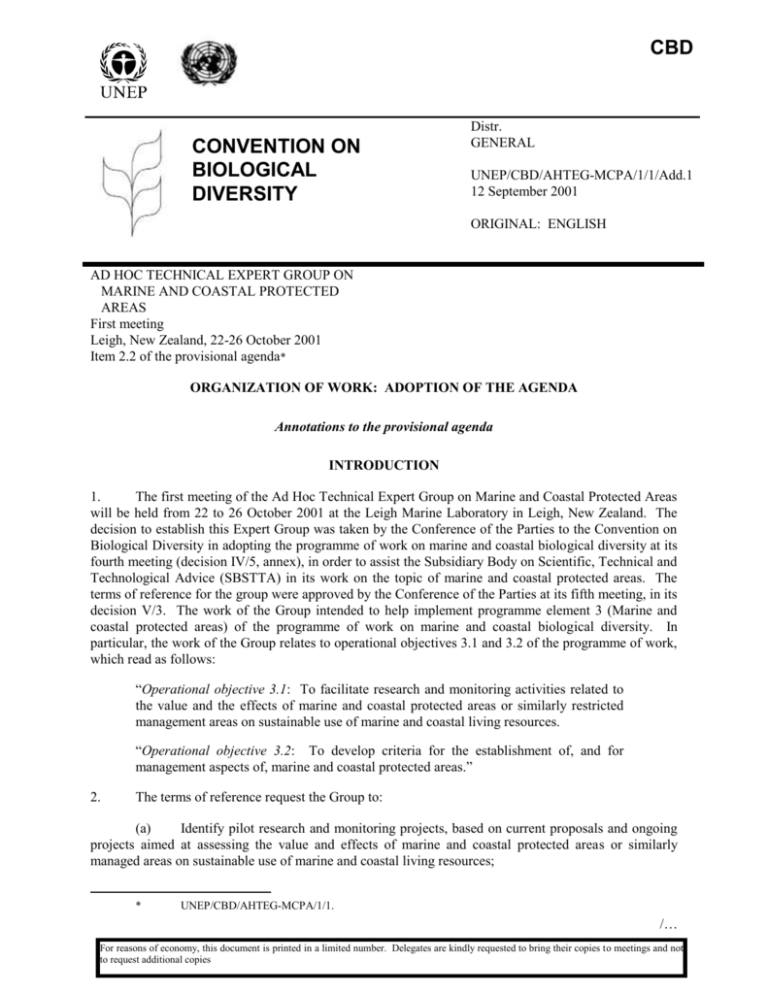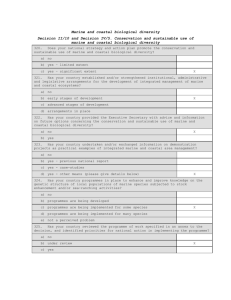English - Convention on Biological Diversity
advertisement

CBD CONVENTION ON BIOLOGICAL DIVERSITY Distr. GENERAL UNEP/CBD/AHTEG-MCPA/1/1/Add.1 12 September 2001 ORIGINAL: ENGLISH AD HOC TECHNICAL EXPERT GROUP ON MARINE AND COASTAL PROTECTED AREAS First meeting Leigh, New Zealand, 22-26 October 2001 Item 2.2 of the provisional agenda* ORGANIZATION OF WORK: ADOPTION OF THE AGENDA Annotations to the provisional agenda INTRODUCTION 1. The first meeting of the Ad Hoc Technical Expert Group on Marine and Coastal Protected Areas will be held from 22 to 26 October 2001 at the Leigh Marine Laboratory in Leigh, New Zealand. The decision to establish this Expert Group was taken by the Conference of the Parties to the Convention on Biological Diversity in adopting the programme of work on marine and coastal biological diversity at its fourth meeting (decision IV/5, annex), in order to assist the Subsidiary Body on Scientific, Technical and Technological Advice (SBSTTA) in its work on the topic of marine and coastal protected areas. The terms of reference for the group were approved by the Conference of the Parties at its fifth meeting, in its decision V/3. The work of the Group intended to help implement programme element 3 (Marine and coastal protected areas) of the programme of work on marine and coastal biological diversity. In particular, the work of the Group relates to operational objectives 3.1 and 3.2 of the programme of work, which read as follows: “Operational objective 3.1: To facilitate research and monitoring activities related to the value and the effects of marine and coastal protected areas or similarly restricted management areas on sustainable use of marine and coastal living resources. “Operational objective 3.2: To develop criteria for the establishment of, and for management aspects of, marine and coastal protected areas.” 2. The terms of reference request the Group to: (a) Identify pilot research and monitoring projects, based on current proposals and ongoing projects aimed at assessing the value and effects of marine and coastal protected areas or similarly managed areas on sustainable use of marine and coastal living resources; * UNEP/CBD/AHTEG-MCPA/1/1. /… For reasons of economy, this document is printed in a limited number. Delegates are kindly requested to bring their copies to meetings and not to request additional copies UNEP/CBD/AHTEG-MCPA /1/1/Add.1 Page 2 (b) Review the desk-study called for in the operational objective 3.1, activity (c), of the programme of work on marine and coastal biological diversity. The desk-study to be conducted by the Executive Secretary consists of gathering and assimilating information relevant to the value and effect of marine and coastal protected areas on sustainable use of marine and coastal biodiversity; (c) Identify linkages between marine protected areas and sustainable use of marine and coastal biodiversity; (d) Prepare recommendations on types of research to be carried out to understand the effects of marine and coastal protected or closed areas on population size and dynamics, subject to national legislation. 3. In the interest of relating the terms of reference more closely to operational objectives 3.1 and 3.2 of the programme of work, it is proposed that they be addressed by the Group in the sequence indicated on the provisional agenda (UNEP/CBD/AHTEG-MCPA/1/1). The provisional agenda provides a logical sequence for discussion and should eliminate potential overlap, while still fulfilling the terms of reference. Because both the first and the fourth items in the terms of reference relate to research projects, they can be considered together. The first item calls for the identification of potential pilot research and monitoring projects from amongst proposed and ongoing projects, while the fourth item calls for recommendations for future research that will assist in understanding the effects of marine and coastal protected areas. These are collectively discussed under agenda items 3.4 (which identifies current efforts and knowledge gaps) and 3.5 (which begins the process of making recommendations for future research and identification of pilot projects). The second item in the terms of reference is discussed under agenda item 3.2, while the third item is discussed under agenda item 3.3. Agenda item 3.1 (which briefly reviews the current status of marine and coastal protected areas) provides the baseline for discussions and potential recommendations called for under agenda item 3. 4. It is expected that during its first meeting, the Group will have initial discussions on all the relevant issues, and outline a scope and strategy for its future work. The group will continue to consult during the inter-sessional period, and finalize its work, which will include a substantive document, during its second meeting. The results of the expert group process will be reported on at the eighth meeting of the Subsidiary Body on Scientific, Technical and Technological Advice (SBSTTA) and the seventh meeting of the Conference of the Parties, where protected areas will be one of the three main topics. 5. A list of documents for the meeting is attached as annex II below. 6. Registration of participants will commence at 9 a.m. on Monday 22 October 2001. ITEM. 1. OPENING OF THE MEETING 7. A representative of the Executive Secretary of the Convention on Biological Diversity will open the meeting at 9:30 a.m. on Monday, 22 October 2001. 8. The participants will be welcomed to the meeting by representative(s) of the Government of New Zealand. 9. A representative of the Executive Secretary of the Convention on Biological Diversity will recall the mandate of the Group from the Conference of the Parties, and review the goals, objectives and expected outputs of the group. 10. The expert group members and observers will be invited to introduce themselves. /… UNEP/CBD/AHTEG-MCPA/1/1/Add.1 Page 3 11. A representative of the New Zealand Department of Conservation will discuss the operation of the group and the role of the observers, including the role and operation of the informal advisory group to the Ad Hoc Technical Expert Group (the wider discussion network, which will provide input to the core Group via e-mail). ITEM 2. ORGANIZATIONAL MATTERS 2.1. 12. Election of officers The Ad Hoc Technical Expert Group will be invited to elect its Chair and its Rapporteur. 2.2. Adoption of the agenda 13. The provisional agenda prepared by the Executive Secretary (UNEP/CBD/AHTEG-MCPA/1/1) will be before the Ad Hoc Technical Expert Group for consideration and adoption. 2.3. Organization of work 14. The Ad Hoc Technical Expert Group is invited to consider the provisional organization of work for the meeting annexed to the present annotated provisional agenda. (Annex I). 15. The Group may wish to work in its entirety in Plenary, without establishing any working groups. ITEM 3. SUBSTANTIVE ISSUES 16. Agenda item 3, the main substantive item of the agenda, contains five sub-items, reflecting the Terms of Reference in the manner described in paragraph 3 above. Each sub-item will be introduced by one of the experts, an invited observer, or the Secretariat. Following the introduction to the topic, the Group will be invited to discuss the issues raised. 3.1. Review of the status of marine and coastal protected areas 17. The number, extent, distribution, nature and biological representation of marine and coastal protected areas globally will be reviewed under this item in order to provide a baseline for further discussion. These issues are elaborated upon in the note prepared by the Executive Secretary (UNEP/CBD/AHTEG-MCPA /1/2). 18. Some of the members of the Ad Hoc Technical Expert Group may wish to give a short presentation on the status of marine and coastal protected areas in their home countries and/or regions. 19. Some of the observers may wish to give a short presentation on the issue as it relates to the work of their agencies/organizations. 20. The Group is expected to discuss whether the current status of marine and coastal protected areas is adequate to protect biological diversity globally, and, if not, to identify key gaps in the protection provided. The Group will consider initial recommendations for future action that could be undertaken within the framework of the Convention. /… UNEP/CBD/AHTEG-MCPA /1/1/Add.1 Page 4 3.2. (a) Review and discussion of: (a) the value and effects of marine and coastal protected areas on marine and coastal biological diversity; and (b) criteria for selection of marine and coastal protected areas The value and effects of marine and coastal protected areas on marine and coastal biological diversity 21. To assist the Group in considering the above, the Executive Secretary has prepared a background note (UNEP/CBD/AHTEG-MCPA/1/2), which provides an initial analysis of this issue. Participants may also propose and discuss other values and effects of marine and coastal protected areas not necessarily anticipated in the background note. 22. After discussing the value and effects of marine and coastal protected areas, the Group is invited to begin an initial discussion on developing guidance for how to optimise the positive effects of marine and coastal protected areas, and the actions that could be undertaken within the framework of the Convention. (b) Criteria for selection of marine and coastal protected areas 23. The question of criteria for the selection of marine and coastal protected areas is discussed in the background note prepared by the Executive Secretary (UNEP/CBD/AHTEG-MCPA/1/2). Participants may also discuss other criteria for selection of marine and coastal protected areas than those referred to in this note. 24. The Group is invited to begin initial discussions on guidance to the Parties to the Convention on designing effective marine and coastal protected areas and protected area networks. 3.3 Identification of linkages between marine protected areas and sustainable use of marine and coastal biodiversity 25. In order to assist the Group in considering this agenda item, the Executive Secretary has included a discussion on sustainable use in the context of marine and coastal protected areas in the background note (UNEP/CBD/AHTEG-MCPA /1/2). Participants may also propose and discuss other sustainable use issues than those elaborated on in the background note. 26. The Group is expected to undertake initial discussion on developing guidance on how to incorporate sustainable fisheries and other sustainable uses with marine and coastal protected areas within the context of integrated marine and coastal area management. 3.4 Identification of knowledge gaps, particularly in understanding the value and effects of marine and coastal protected areas on sustainable use of marine and coastal living resources, and on population size and dynamics; and identification of existing efforts to fill those gaps 27. Some of the expert participants may give a short presentation on the key knowledge gaps identified in their countries/regions and on ongoing and planned research and monitoring projects to fill those gaps. 28. Some of the observers may make a short presentation on related regional/global research and monitoring projects their agencies or organizations are involved in, and on the reasons these projects were selected. /… UNEP/CBD/AHTEG-MCPA/1/1/Add.1 Page 5 29. The Chair will summarize the input provided by the informal advisory group to the Ad Hoc Technical Expert Group (the discussion network) on this topic. 30. The Group will discuss the key knowledge gaps, and review the adequacy of existing research and monitoring programmes to fill those gaps. 3.5 Identification of potential pilot research and monitoring projects to supplement and reinforce the existing efforts 31. The Group will begin initial discussions on recommendations for future research, including collaborations with existing projects and programmes, and the financial implications of undertaking these projects, including the special needs of developing country Parties, in particular the least developed and small island developing states among them, and countries with economies in transition. 32. In addition, the group will also begin the process of identifying pilot projects from amongst proposed and ongoing projects. These pilot projects should assess the value and effects of marine and coastal protected areas on sustainable use of marine and coastal biodiversity. 33. Both the recommendations for future research and the identified pilot projects may also include use of demonstration sites employing best practices, studies on strengthening management effectiveness, and capacity building, including technology transfer, as well as more research-oriented projects. ITEM 4. PREPARATION FOR THE SECOND MEETING 34. The Group is invited to discuss the draft provisional agenda for the second meeting. The date and venue for this meeting will also be discussed. 35. The group is also invited to consider the inter-sessional work to be undertaken prior to the second meeting of the ad hoc technical expert group, and how this work, including the substantive document, will contribute to the eighth meeting of the Subsidiary Body on Scientific, Technical and Technological advice, and the seventh meeting of the Conference of the Parties to the Convention. ITEM 5. OTHER MATTERS 36. Under this item, participants will be invited to raise other matters related to the subject matter of the meeting. ITEM 6. ADOPTION OF THE REPORT 37. The Group will consider and adopt its report, on the basis of the draft report of the meeting and draft recommendations to be presented by the Rapporteur. ITEM 7. 38. CLOSURE OF THE MEETING It is expected that the meeting will be closed at 5 p.m. on Friday, 26 October 2001. /… UNEP/CBD/AHTEG-MCPA /1/1/Add.1 Page 6 Annex I PROVISIONAL PROGRAMME OF WORK FOR THE FIRST MEETING OF THE AD HOC TECHNICAL EXPERT GROUP ON MARINE AND COASTAL PROTECTED AREAS* Monday, 22 October 2001 9:30 a.m. Opening of the meeting (agenda item 1) Morning Organizational matters (agenda item 2) Afternoon Review of status of marine and coastal protected areas (agenda item 3.1) Tuesday, 23 October 2001 Morning/afternoon Review and discussion of the desk study (agenda item 3.2) Wednesday, 24 October 2001 Morning/afternoon Identification of linkages between marine protected areas and sustainable use of marine and coastal biodiversity (agenda item 3.3) Thursday 25 October 2001 Morning Identification of knowledge gaps (agenda item 3.4) Afternoon Identification of potential pilot research and monitoring projects (agenda item 3.5) Friday 26 October 2001 Morning Preparation for the second meeting (agenda item 4) Other matters (agenda item 5) Afternoon Adoption of the report (agenda item 6) 5:00 pm Closure of the meeting (agenda item 7) * Please note: Field trips may be arranged by the host country to supplement the agenda. /… UNEP/CBD/AHTEG-MCPA /1/1/Add.1 Page 7 Annex II LIST OF DOCUMENTS FOR THE FIRST MEETING OF THE AD HOC TECHNICAL EXPERT GROUP ON MARINE AND COASTAL PROTECTED AREAS Working documents UNEP/CBD/AHTEG-MCPA/1/1 Provisional agenda UNEP/CBD/AHTEG-MCPA/1/1/Add.1 Annotations to the provisional agenda UNEP/CBD/AHTEG-MCPA/1/2 The value and effects of marine and coastal protected areas on marine and coastal biological diversity Information documents UNEP/CBD/AHTEG-MCPA/1/INF/1 Information for participants UNEP/CBD/AHTEG-MCPA/1/INF/2 The role of protected areas within the Convention on Biological Diversity Other documents The following additional documents are only available in hard copy and will be distributed at the meeting: [No symbol] Proceedings of the Second International Symposium and Workshop on Marine and Coastal Protected Areas: Integrating Science and Management (published by NOAA and the U.S. Man and Biosphere Program, 1997. M. Crosby (Ed.)) [No symbol] Alternative Access and Management Strategies for Marine and Coastal Protected Areas (published by the U.S. Man and Biosphere Program, 2000. M. Crosby, K. Geenen and R. Bohne (Eds.)) [No symbol] Legal Regulations, Legal Instruments and Competent Authorities with Relevance for Marine Protected Areas (MPAs) in the Exclusive Economic Zone (EEZ) and the High Seas of the OSPAR Maritime Area (by D. Czybulka and P. Kersandt, the Federal Agency for Nature Conservation, Bonn, Germany, 2000) -----






